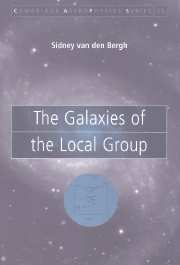Book contents
- Frontmatter
- Contents
- Preface
- 1 Introduction
- 2 Local Group membership
- 3 The Andromeda galaxy (M31)
- 4 The Milky Way system
- 5 The Triangulum galaxy (M33)
- 6 The Large Magellanic Cloud
- 7 The Small Magellanic Cloud
- 8 The elliptical galaxy M32 (= NGC 221)
- 9 The irregular dwarf galaxy NGC 6822
- 10 The starburst galaxy IC 10
- 11 Faint dwarf irregular galaxies
- 12 Spheroidal galaxies
- 13 The most luminous dwarf spheroidal galaxies
- 14 Dwarf spheroidals in the Andromeda subgroup
- 15 Faint dwarf spheroidals
- 16 The outer fringes of the Local Group
- 17 Intergalactic matter in the Local Group
- 18 Dynamical and physical evolution
- 19 Properties of the Local Group
- 20 Conclusions
- Glossary
- Bibliography
- Object Index
2 - Local Group membership
Published online by Cambridge University Press: 22 August 2009
- Frontmatter
- Contents
- Preface
- 1 Introduction
- 2 Local Group membership
- 3 The Andromeda galaxy (M31)
- 4 The Milky Way system
- 5 The Triangulum galaxy (M33)
- 6 The Large Magellanic Cloud
- 7 The Small Magellanic Cloud
- 8 The elliptical galaxy M32 (= NGC 221)
- 9 The irregular dwarf galaxy NGC 6822
- 10 The starburst galaxy IC 10
- 11 Faint dwarf irregular galaxies
- 12 Spheroidal galaxies
- 13 The most luminous dwarf spheroidal galaxies
- 14 Dwarf spheroidals in the Andromeda subgroup
- 15 Faint dwarf spheroidals
- 16 The outer fringes of the Local Group
- 17 Intergalactic matter in the Local Group
- 18 Dynamical and physical evolution
- 19 Properties of the Local Group
- 20 Conclusions
- Glossary
- Bibliography
- Object Index
Summary
Introduction
Critical discussions of membership of individual galaxies in the Local Group have recently been given by van den Bergh (1994a,b, 1999), by Grebel (1997), and by Mateo (1998). A galaxy distance ≲1.5 Mpc was used as a preliminary selection criterion for Local Group membership. A detailed discussion of additional selection criteria will be given in Chapter 16 of the present volume, which deals with the membership of individual galaxies located near the outer fringes of the Local Group. Table 2.1 presents a summary of the observational parameters for the 35 most probable members of the Local Group. This table lists the name and (where appropriate) one alias for each Local Group member, its DDO classification (mostly from van den Bergh 1966a), the J2000 coordinates of each galaxy, its observed heliocentric velocity, its integrated magnitude in the V band, and its reddening E(B – V). The derived parameters for each of these galaxies, basedon the discussion in the present volume, will be given in Table 19.1.
Incompleteness of the sample
The fact that IC 1613 (MV = -14.9) has been known (Dyer 1895) for about a century indicates that our Local Group sample (at least outside the zone of avoidance at low Galactic latitudes) is almost certainly complete for objects brighter than MV = -15. The fact that Irwin (1994) discovered only a single new Local Group member during a survey of ∼ 20,000 square degrees at high Galactic latitudes suggests that the search for Galactic satellites at high latitudes is probably complete to at least MV =-10.
- Type
- Chapter
- Information
- The Galaxies of the Local Group , pp. 4 - 8Publisher: Cambridge University PressPrint publication year: 2000
- 6
- Cited by

